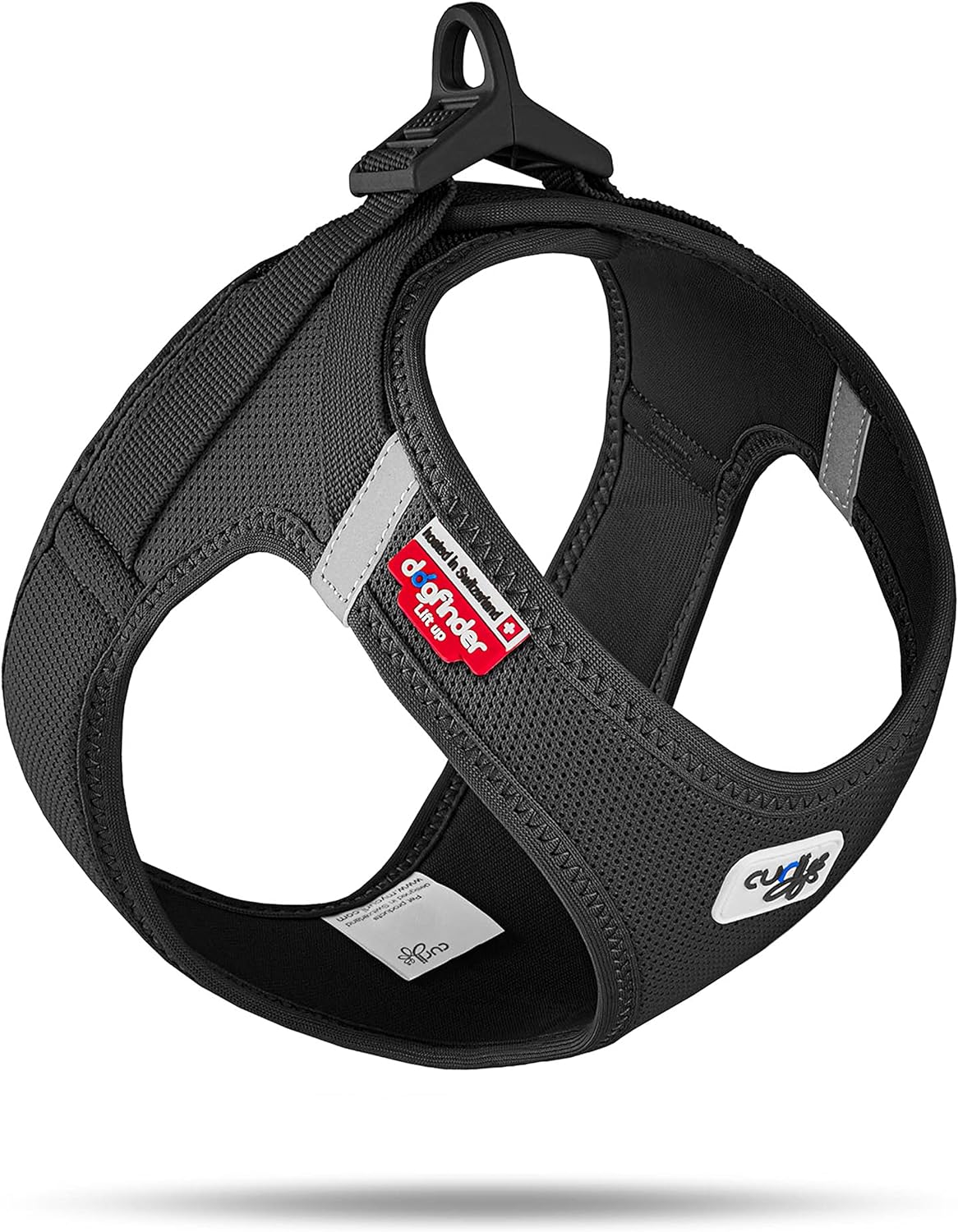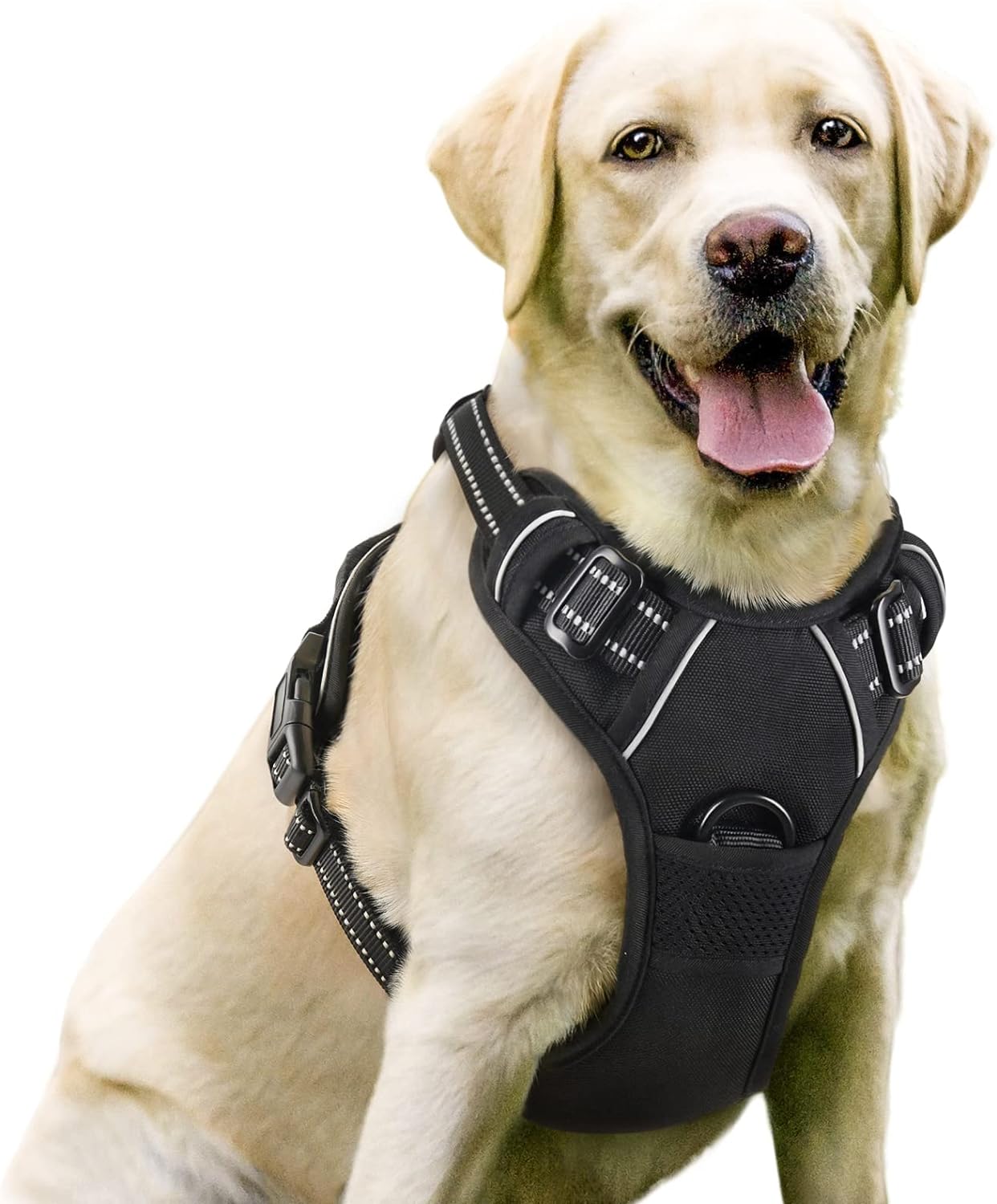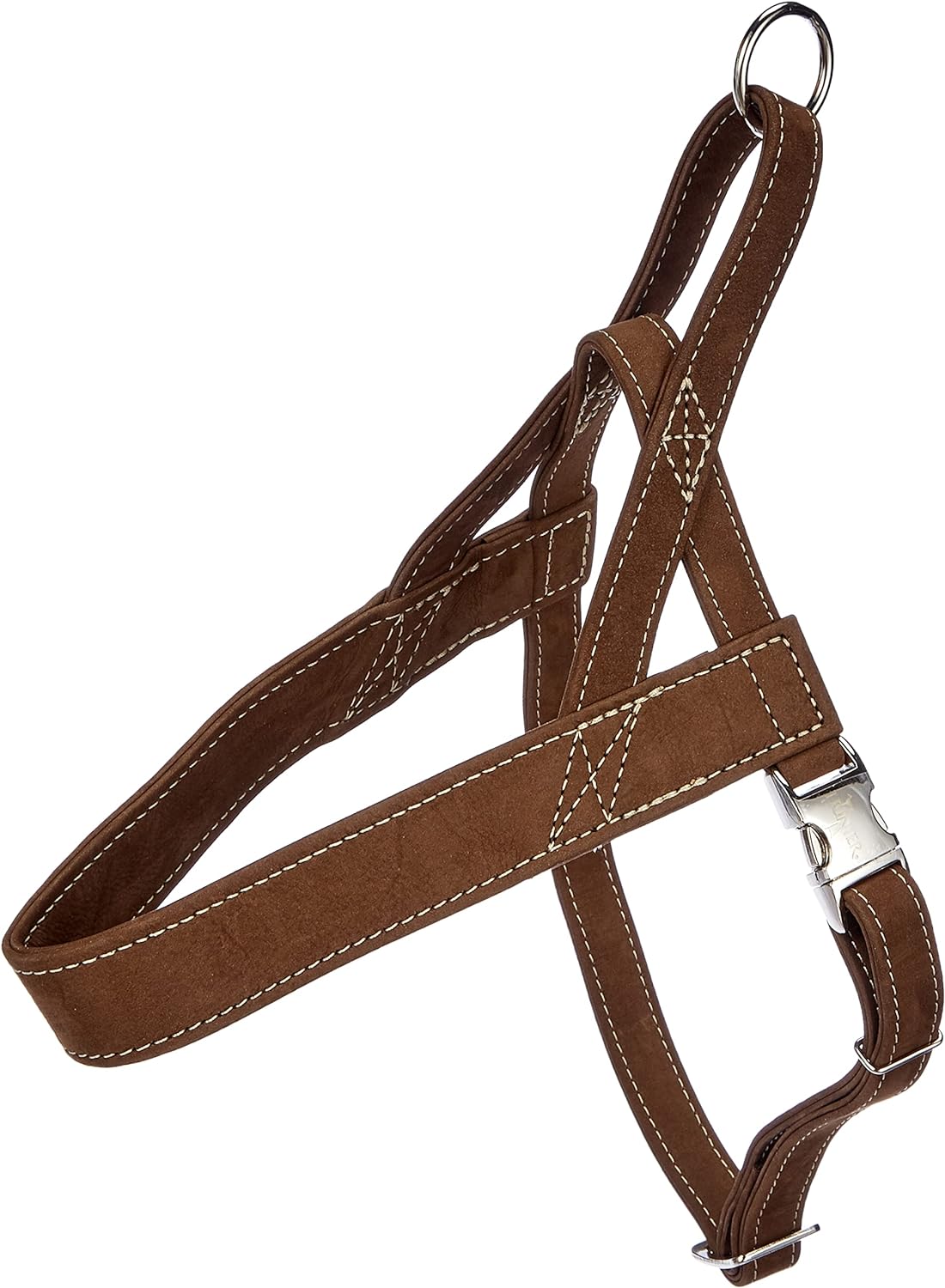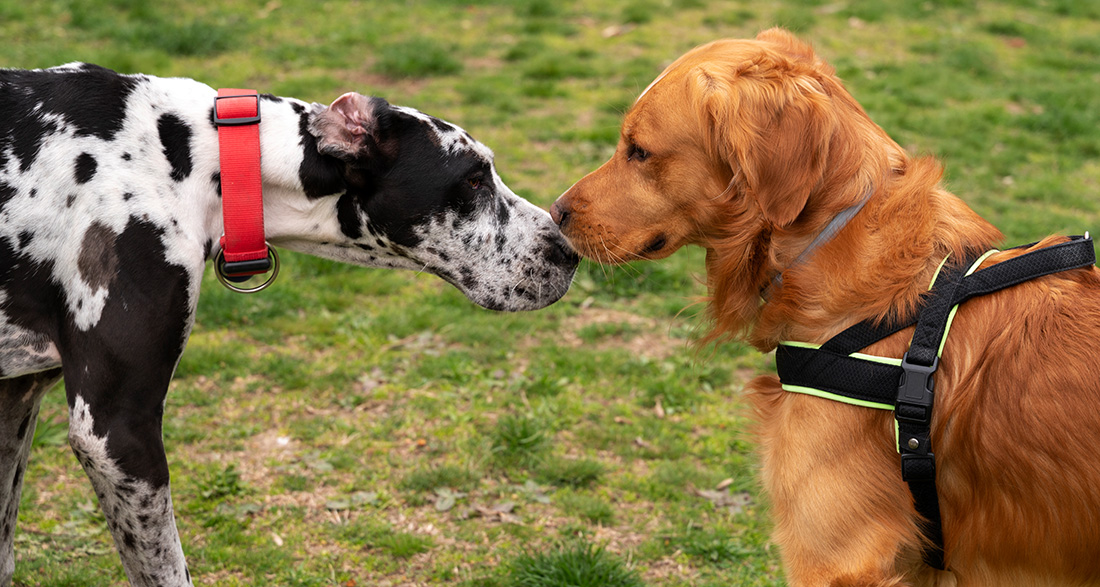When it comes to choosing between a dog harness and a collar, there are many things to consider. Every dog is unique and has its own needs. In this article, we will examine the pros and cons of dog harnesses and collars to determine which is the best choice for your dog.
- Dog Harness vs. Collar: Which Is Right for Your Dog?
- Pros and Cons of Dog Harnesses
- Why Collars Are Not Always the Best Choice
- Leash Training: Tips for a Relaxed Walk
- The Ultimate Guide to Dog Harnesses
- Which Leading Harness Best Fits Your Dog?
- Benefits of Norwegian Harnesses
- Saddle Harnesses: An Alternative for Special Needs
- Finding the Right Size: Ensuring the Perfect Fit for the Dog Harness
iHugDogs is reader-supported. All of the links below may be paid affiliate links, where we receive a small commission on a product at no additional cost to you.
Dog Harness vs. Collar: Which Is Right for Your Dog?
The decision between a dog harness and a collar depends on many factors. It’s essential to consider the pros and cons of both options to make the best choice.
Pros and Cons of Dog Harnesses
A dog harness offers many advantages. It distributes the dog’s weight evenly across the body, reducing the risk of injuries to the neck. This is particularly important for dogs with sensitive necks or respiratory issues. A dog harness also provides more control and restraint during walks, especially for dogs that tend to pull.
Another advantage of dog harnesses is that they have various attachment points where the leash can be connected. This allows for varying the pulling point and better guiding the dog. Some dog harnesses also have additional straps or handles, making it easier to control the dog in challenging situations.
However, there are also drawbacks. Some dogs may not like wearing a harness and may try to remove it, posing a safety risk, especially if the dog frees itself during a walk. Additionally, a harness can restrict the dog’s freedom of movement, especially if not properly fitted. It’s crucial to choose the right size and fit for the harness to avoid these issues.
Vest Harness curli Clasp Air-Mesh Black

What We Like:
- Perfecting the top-selling dog harness: The curli safety harness is around 20% lighter than its predecessor (from 33g) and comes with significantly improved ergonomics and optimized fit!
- Thoughtful dog accessory with a strong curli clasp buckle: Attach your leash with just one hand to the noise and weight-reducing buckle, which holds loads over 70 kg thanks to the high-strength material!
- Even more comfortable for your beloved pet: The optimized Air-Mesh material ensures the highest comfort for your dog, while the harness buckle is padded, protecting the four-legged friend from pressure points during play.
- Perfect for the sensitive dog body: The dog accessory impresses with a perfected cut and optimized load distribution, as well as a Velcro closure for detailed adaptation to the body shape – so nothing stands in the way of your adventure!
- Scope of delivery: curli Vest Harness Clasp Air-Mesh Dog Harness (safe harness with over 70 kg load capacity, no pressure points, improved fit, harness with curli clasp buckle) – Size: S – Black
Why Collars Are Not Always the Best Choice
Collars are popular among many dog owners because they are easy to put on and comfortable to wear. They work well for dogs that already walk well on a leash and have no issues with pulling.
However, a disadvantage of collars is that they can increase the risk of injuries to the neck, especially if the dog pulls strongly. They can lead to respiratory issues and damage to the spine, especially in dogs with a short neck or anatomical peculiarities.
Another drawback of collars is that they provide less control and restraint compared to dog harnesses. When a dog pulls strongly, it can be challenging to control them with a collar, leading to uncomfortable walks and jeopardizing the safety of the dog and its owner.
It’s also important to note that collars are not suitable for all dog breeds. Dogs with sensitive necks or respiratory issues should not wear a collar as it may impact their health.
Ultimately, the choice between a dog harness and a collar depends on the individual needs and characteristics of the dog. It is advisable to consult with a veterinarian or a professional dog trainer to determine the best option for your dog.

What We Like:
- Easy On and Off: This harness, without any pulling on the neck, features a snap closure for the body and neck, making it much easier to put on and take off. The dog’s head does not need to be forced through the harness, and the ears remain unharmed.
- No Pulling and Choking: The front metal D-ring is excellent if you have a dog that has not yet learned not to pull on the leash. When the dog pulls, it turns back to you, quickly learning to stop pulling. Additionally, it is soft and breathable, non-toxic with mesh fabric padding, evenly distributing the pulling pressure on the body to prevent choking.
- High-Quality Material: The straps and durable fabric are comfortable and do not interfere or irritate during movement. Breathable mesh lining with soft padding prevents injuries to the dog and provides additional comfort and protection.
- Perfect Control: There is a soft handle on the top that you can hold onto to maintain control over your dog when it gets excited or needs help. It can easily restrain dogs and is also perfect for guiding them on stairs, steps, and in cars, etc.
- Fully Adjustable: 4-way adjustable straps at the neck and chest for a custom fit with extra room to grow. Please measure your dog to determine the correct size before purchasing.
Leash Training: Tips for a Relaxed Walk
Regardless of whether you choose a dog harness or a collar, leash training is an essential aspect of walking your dog. Here are some tips to achieve a relaxed walk with your dog:
- Start with short walks and gradually increase the duration.
- Reward your dog when walking calmly on the leash.
- Use positive reinforcement to reward good behavior.
- Avoid pulling or jerking on the leash.
- Use calm and gentle corrections when your dog pulls or becomes inattentive.
A relaxed walk with your dog can be a wonderful way to spend time together while fulfilling the needs of your furry friend. However, it’s crucial to understand and apply the basics of leash training to ensure a pleasant experience for both you and your dog.
The first tip is to start with short walks and gradually increase the duration. This allows your dog to get used to walking on a leash and gradually build its endurance. It’s important to be patient and give your dog enough time to adapt to the new routine.
During the walk, it’s essential to reward your dog when walking calmly on the leash. This can be done through treats, praise, or petting. By reinforcing positive behavior, your dog will learn that it’s worth staying on the leash and walking calmly.
Positive reinforcement is a crucial part of leash training. When your dog exhibits good behavior, you should reward it. This can be done through verbal confirmation, treats, or toys. Using positive reinforcement will motivate your dog to maintain the desired behavior.
It’s important to avoid pulling or jerking on the leash. This can cause pain or discomfort to your dog and make walking an unpleasant experience. Instead, use calm and gentle corrections when your dog pulls or becomes inattentive. This can be achieved through a slight change in direction or a short tug on the leash.
Remember that leash training takes time and practice. Be patient and consistent in applying the tips we have discussed. Over time, your dog will learn to walk calmly on the leash and enjoy the walking experience.
The Ultimate Guide to Dog Harnesses
When choosing a dog harness, you have various options to consider. Here are some popular types of dog harnesses:
When purchasing a dog harness, there are many factors to consider. In addition to design and color, it’s crucial to select the right harness for your dog that meets its individual needs.

What We Like:
- No More Pulling: Walking or jogging with a dog that pulls excessively affects your arms, nerves, and the quality of the walk. The No-Pull design significantly reduces the annoying pulling of the dog. Relax your arm muscles and have better control over your “energy quadruped.” Let your dog feel comfortable. The pulling pressure is evenly distributed across the dog’s body, avoiding pulling and choking on the neck and head.
- Adjustable Fit: Measure before buying! Size: L, Neck Girth: 46cm – 66cm, Chest Girth: 43cm – 86cm, fits well with small to large household dogs. For example, Beagle, Pug, Poodle, Schnauzers, Pomeranian, Bichon, Cavalier King Charles Spaniel, Dachshund, French Bulldog, etc. The straps and adjustable buckles allow a comfortable fit for dogs. Leave 2 fingers of space at the chest and neck for freedom of movement.
- Better Control with Two Rings: With 2 attachment rings, you can guide your dog on the back or chest. The front ring allows excellent correction of the dog, just what you want. Attaching the leash to the back is more comfortable for the dog than a collar. Also, with the handle on the back, you can better control your dog in some tense situations.
- High-Quality Sporty Harness: Your dog looks chic and sporty with the harness. The harness is breathable, beautifully soft, and padded with Oxford cloth and cotton. The padding in the chest area not only provides a comfortable feeling but also keeps the dog clean on rainy days. It can be hand-washed and dries quickly.
- Safety at Night and in the Car: The reflectors are visible in the dark and suitable for jogging. This ensures your dog’s safety during dusk, night, fog, or rainy days through reflectors. You can also use the harness as a car safety harness. Please buckle your dog with the seatbelt to keep your dog safe in the car. If you suddenly stop, it won’t become a flying projectile.
Which Leading Harness Best Fits Your Dog?
There are different types of leading harnesses, including Norwegian harnesses and saddle harnesses. The best fit for your dog depends on its size, behavior, and individual needs.
The Norwegian harness is a popular choice for many dog owners. It features a simple construction that evenly distributes pressure on the chest and shoulders. This provides good control and comfort for the dog. The Norwegian harness is especially suitable for dogs that like to pull or have strong pulling force.
Another popular leading harness is the saddle harness. It provides additional support and stability for dogs with back or joint problems. The saddle harness can also be used to help dogs climb stairs or jump. It is a good choice for dogs with special needs that require additional support.
Benefits of Norwegian Harnesses

What We Like:
- Norwegian harness with high-quality nylon material and reflective stripes for dogs
- Ideal for jogging and cycling with the dog
- Particularly comfortable and fur-friendly thanks to fleece padding in the chest, neck, and shoulder areas
- With individually adjustable belly strap for optimal comfort
- Size: Adjustable belly circumference: 52 – 62 cm | Width 2.5 cm
Norwegian harnesses are a popular choice for dogs of all sizes. They feature a simple construction that evenly distributes pressure on the chest and shoulders, providing good control and comfort for the dog.
Another advantage of Norwegian harnesses is their simplicity. They are easy to put on and offer a secure fit for the dog. The even distribution of pressure prevents unnecessary strain on the dog, allowing it to move freely.
Norwegian harnesses are also available in various sizes and designs, allowing you to choose the right harness for your dog. Whether you have a small Chihuahua or a large German Shepherd, there is a Norwegian harness that fits perfectly.
Saddle Harnesses: An Alternative for Special Needs

What We Like:
- Size: Chest Girth: 40-53 cm, Dog Weight: 4-7 kg. To see more products, visit the Amazon Julius-K9 Store!
- Traditional Comfort and Convenience: perfect attire both in the park and on the streets – since 1997
- The world’s first dog harness with interchangeable velcro patches: Choose from a variety of different patches to express your dog’s personality or mood or provide useful information on the harness.
- Robust and Resilient Design: With its sturdy handle, you can easily control your dog when needed. Safety is increased by the break-proof buckle and reflective elements on the dog harness. Water-resistant dog harness made of premium materials.
- Exceptionally Easy to Put On: just one click, and the walk can begin!
Saddle harnesses are an alternative for dogs with special needs. They provide additional support and stability for dogs with back or joint problems. Saddle harnesses can also be used to help dogs climb stairs or jump.
A saddle harness consists of a chest plate and a back piece that are connected. It offers a secure fit and supports the dog in the right areas. The additional stability can make the dog feel safer and more comfortable.
Saddle harnesses are available in various sizes and can be adjusted to fit your dog’s individual needs. They provide a good alternative for dogs that require additional support due to injuries or conditions.
Finding the Right Size: Ensuring the Perfect Fit for the Dog Harness
To ensure that the dog harness fits perfectly, it’s important to choose the right size.
Here are some tips on how to find the right size for your dog harness:
- Measure your dog’s chest girth.
- Check the manufacturer’s size chart.
- Choose an adjustable dog harness.
- Try on the harness and pay attention to the fit and freedom of movement for your dog.
The choice between a dog harness and a collar depends on the individual needs and preferences of your dog. It’s important to consider the pros and cons of both options and ensure that the selected product fits well, providing comfort and safety to your dog. By choosing the right equipment and training good leash manners, you can contribute to relaxed and enjoyable walks with your dog.
Your dog’s chest girth is a crucial factor in selecting the right dog harness. To measure the chest girth, use a flexible tape measure and wrap it around the widest part of your dog’s chest. Make sure the tape measure is snug but not too tight. Record the result as you will need it later for the manufacturer’s size chart.
The manufacturer’s size chart is a useful tool for finding the right size for the dog harness. Each manufacturer may have different size specifications, so it’s essential to use the chart provided by the specific manufacturer. Compare your dog’s chest girth with the measurements in the chart to determine the appropriate size.
An adjustable dog harness offers the advantage of being able to be tailored to your dog’s individual needs. It allows for a precise fit, ensuring that the harness is neither too tight nor too loose. Ensure that the harness is made from high-quality materials and has sturdy fasteners to ensure your dog’s safety.
When trying on the dog harness, pay attention to its fit and whether it provides sufficient freedom of movement for your dog. It should be snug enough to prevent slipping but not so tight that it’s uncomfortable or restricts your dog’s breathing. Let your dog take a few steps, observing whether the harness sits correctly and doesn’t cause chafing or rubbing.
The choice between a dog harness and a collar depends on various factors. A dog harness is particularly suitable for dogs with sensitive necks or respiratory issues as it distributes pressure across the chest. It also offers more control over your dog during walks. On the other hand, a collar can be a good option if your dog already walks well on a leash and has no specific needs.
It’s important to weigh the pros and cons of both options, considering your dog’s individual needs and preferences. If in doubt, consult a veterinarian or a dog trainer to make the best choice for your dog.
By choosing the right equipment and training good leash manners, you can contribute to relaxed and enjoyable walks with your dog. Well-fitted and comfortable gear allows your dog to move freely while being secure and protected. Take the time to find the right size and adjust the dog harness properly to ensure the best possible experience for both you and your dog.


